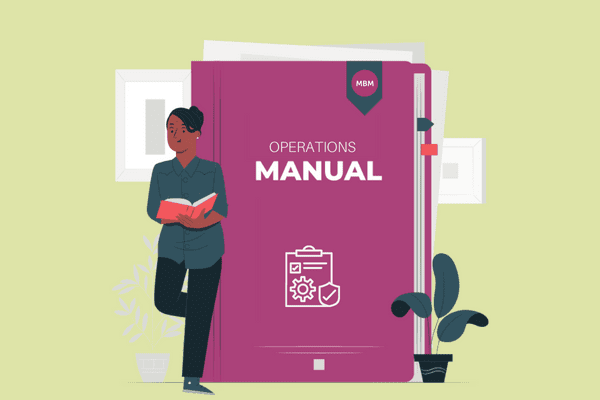The HR Tool You Never Knew You Needed
To think, if you had told me five years ago that I would write an operations manual for my nursery, I would have laughed out loud.
I believed that to operate a truly child-centred nursery business, you needed not to have systems and processes. In fact, I recall believing that, “systems and processes are for factories, not childcare!”
I was wrong!
Human Resource (HR) professionals play a vital role in ensuring that their organisations comply with best practices, such as those established by the Chartered Institute of Personnel and Development (CIPD). In my sector, this role is often one of the many tasks carried out by the owner or manager of the nursery.
One of the most important tools that HR professionals can use to help ensure compliance with best practices is the operations manual. The document outlines an organisation’s standard operating procedures (SOPs), policies, and guidelines, and serves as a reference for all employees.

Why an Operations Manual?
For those not familiar with HR processes, understanding what an operations manual’s purpose is is key. So only then can those from outside the field of HR begin to buy into its place in their business.
Serves as a Reference Point:
Firstly, an operations manual is a crucial tool for ensuring consistency in an organisation’s procedures and policies. It provides a clear and concise reference for employees to follow, which reduces the likelihood of mistakes, misunderstandings, or deviations from established practices.
This, in turn, helps to minimise risk and improve efficiency, as employees are better equipped to carry out their tasks with confidence and accuracy. Moreover, an operations manual helps to ensure that all employees are treated fairly and equitably, as it sets out the organisation’s policies and procedures in a clear and transparent manner. This can help to prevent issues such as discrimination, harassment, or favouritism, as all employees are held to the same standards and procedures.
For Communication and Collaboration:
Secondly, an operations manual can help to improve communication and collaboration within an organisation. By providing a shared reference point for all employees, the manual can help to clarify roles, responsibilities, and procedures. This can help to prevent misunderstandings or conflicts, as employees are better able to work together effectively.
Furthermore, an operations manual can help to foster a culture of continuous improvement, as it provides a framework for reviewing and updating procedures and policies in light of changing circumstances or feedback from employees. This can help to ensure that the organisation remains flexible and responsive to new challenges, opportunities, or trends.
Sticky Learning ® is 7 times more effective than 1-day training courses. Plus, you will get a Chain of Evidence proving your Return on Investment. Discover soft skills training that changes behaviours long term.

For Legal and Ethical Obligations:
Thirdly, an operations manual is a valuable tool for managing risk and ensuring compliance with legal and ethical obligations. By documenting procedures and policies, the manual can help to ensure that the organisation is following best practices and complying with relevant laws and regulations. This can help to minimise the risk of legal or reputational issues, as the organisation can demonstrate that it has taken steps to meet its obligations.
Furthermore, an operations manual can help to ensure that employees are aware of their obligations and responsibilities, and can help to prevent issues such as negligence, fraud, or corruption.
What’s Typically Included in an Operations Manual

An Operations Manual typically contains detailed information and instructions about how to run a business or organisation effectively. Though the specific contents of an Operations Manual can vary depending on the organisation and its industry, it typically covers the following areas:
1. Overview of the Organisation:
This section provides a general overview of the organisation, its mission, and its goals.
1. Overview of the Organisation:
Subsequently, this section describes the organisational structure, including the roles and responsibilities of different organisational positions.
3. Policies and Procedures:
This section outlines the policies and procedures that govern the organisation’s operations, including procedures for handling customer complaints, managing finances, and dealing with emergencies.
4. Standard Operating Procedures:
This section provides detailed instructions for performing specific tasks, such as processing orders, handling inventory, and maintaining equipment.
5. Training and Development:
This section outlines the organisation’s training and development programs, including onboarding new employees and providing ongoing training for existing staff.
6. Health and Safety:
This section provides information on the organisation’s health and safety policies and procedures, including protocols for dealing with accidents or injuries.
7. Quality Control:
Lastly, this section outlines the organisation’s quality control processes, including measures to ensure that products or services meet or exceed customer expectations.
📥 Access Your Free Operations Manual Extract
Final Words… It’s Not as Simple as It Looks
Lastly, the importance of HR professionals advocating for the creation of an operations manual cannot be overstated. The benefits of having a clear and concise reference for all employees are numerous and can include improved consistency, communication, collaboration, risk management, and compliance.
By providing a shared framework for all employees to follow, an operations manual can help to ensure that an organisation remains efficient, effective, and responsive to changing circumstances.
Simple?
Just sit on it for a moment and think about the tasks involved in each of those headings. Because the magnitude of the task that stood before me was overwhelming. Without really knowing what I was doing, I started to write.
The first draft took nine months to get to a stage where I could share it with the team and invite feedback and suggestions. This had been a gruelling time for me and an actual labour of love. I had completed ensuring degrees with less pressure and tears.
To say that the operations manual has transformed mu business is not an understatement. I would be as bold as to say it saved my physical and mental health. For the first time in over a decade, my nursery was consistent. It was not draining every ounce of energy from me. I was not saying the same things over and over and over. The team blew me away by embracing this new way of working. Autonomy, innovation and morale exploded, and life as a nursery owner became joyful again.
Moreover, I am so passionate about how much this process has changed my life and my business that I have created a full development programme for other nursery owners and childminders that co-creates your very own, bespoke operations manual.
Join our email newsletter for more useful content coming your way!
References:
Chartered Institute of Personnel and Development. (2018). Human resource management in context: Insights, strategy and solutions. Kogan Page Publishers.
Department for Business, Energy & Industrial Strategy. (2018). Non-financial reporting: government response to the consultation on the implementation of the EU directive on the disclosure of non-financial and diversity information by certain large undertakings and groups. Author.
Martin, G., & Reddington, M. (2017). Human resource management: Theory and practice. SAGE Publications.




